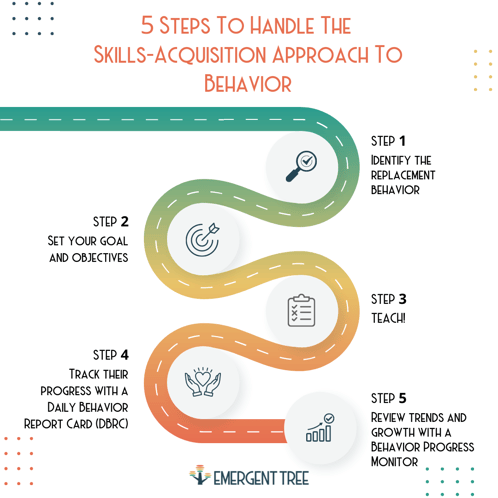Skills. Behavior. Goals. Oh My.
Taking a Skills-Acquisition Approach to Behavior
A big part of teaching is understanding your students, their needs, challenges, strengths, and what helps or hinders their productive learning. Different things can affect how your students engage in the classroom, and, as a teacher, it’s essential to be aware of these factors and select effective interventions to support them.
When taking a skills approach to behavior, we first must realize challenging behavior is likely due to a skill or performance gap. Either the student doesn't know what to do in a particular situation (skill gap) or they do have the skill but due to various factors (i.e., anxiety over a difficult task) can't fully use the skills they have at that moment. Setting goals around replacement behaviors and coping skills can support students in moving from their current behavior to the behavior we would like them to display - the replacement behavior. Similar to the skills-acquisition approach to learning multiplication, our students can learn how to react and respond to their environment and others with healthy, supportive behavior.
How do we handle the skills-acquisition approach to behavior in Tier 2 and Tier 3?
The simplest answer to this is - goals, but let’s unpack that a bit to understand how to create a plan for success around goals.
Step 1: Identify the replacement behavior - the new skill you want the student to use
This could look like identifying more appropriate ways to gain attention, asking for permission when needing a break, etc. At Tier 2 we often anchor to the campus core values of school-wide expectations to determine replacement behaviors. If we are supporting at the Tier 3 levels, we begin to individualize goals based on students' function of behavior.
Step 2: Set your goal and objectives
What would success look like for improvement? What skills do they need to master first before being fully independent with their goal? How do we scaffold or sequence these skills to help shape behavior toward the ultimate goal? Consider the scale below as a guideline for thinking about how to scaffold replacement behaviors.
- 1 - Regression: Something likely triggered the behavior that needs to be addressed. These behaviors do not occur daily, but they are important to track as we know they can happen.
- 2 - Present level: Students showed habitual behaviors without forward movement. These are the behaviors you always see and are trying to improve.
- 3 & 4 - Approximate: Students implement the skills and strategies they are taught in interventions to help them reach their goals.
- 5 - Goal: Students achieved their behavior goal.
Step 3: TEACH!
Any skills-based approach must include good instruction. We wouldn't expect a student to master a new academic skill without direct instruction, practice, and feedback - new behavioral skills require this too!
We have to meet the students where they are. Helping them visualize the behavior through modeling, role-playing, and social stories helps them connect with the goals they are trying to accomplish. This isn't a one-time action but needs ongoing feedback, prompting, and reinforcement for students to master and generalize the new skill to all settings.
Step 4: Track their progress with a Daily Behavior Report Card (DBRC)
Tracking student progress on these goals is where the magic happens. We suggest identifying at least four times a day (otherwise known as reporting intervals) that you will monitor this behavior.
The Daily Behavior Report Card that we utilize operates on the same 5-point scale described above when setting the goal. During a given interval - what behaviors on this 5-point scale did you see? Simple as that!
This easy tracking approach allows us to see where the new skills are being used most frequently and what times of day we may need to provide more support to help the student fully generalize the skill - addressing any performance gaps that might remain after initial instruction.
Step 5: Review trends and growth with a Behavior Progress Monitor
Every day is different for our students because of external factors they face outside of the school day and internal challenges we may not always be aware of. Seeing a student’s progress with their behavior over time can give us invaluable insight into how to shift our supports.
The Behavior Progress Monitor Tool provides a user-friendly way to keep track of the student’s data (DBRCs) completed each day for your students. By entering your student’s scores daily, you can look at trends in behavior. Is there a particular time of day they typically are challenged? Are there different circumstances (like having a substitute teacher or an environment change) that can trigger regression?
Seeing the big picture allows you to provide intervention feedback to your students, which they need to excel.

Ideas for monitoring behavior progress:
- Figure out a consistent routine - When and how often will you track your data in the Behavior Progress Monitor Tool? This may be a rhythm you can set at the end of each day. By consistently entering your data into the Progress Monitor Tool, you are less likely to have data that builds up over time and is not entered into the system.
- Spend time reviewing the data - look for trends and insights that will help you shift your teaching methods. Just the function of tracking things won’t drive change. Find opportunities to try new approaches, skills, replacement behaviors, etc., with your students to see what could help them reach their behavioral goal.
The path to solid behavior supports can sometimes feel daunting and even siloed.
Seek support. Advocate for yourself and your students. Look for ways to engage and gain ideas from other teachers and district leaders.
Your students need to know they aren’t alone in this, but YOU also need to have the support you need.
If you’re ready to take your learning to the next level, here are some more resources to help you out:
Schedule a Demo: Behavior Progress Monitor Tool
Most school progress monitoring primarily tracks challenging behaviors. But real progress is best measured by understanding students’ skills, when they can use them, and under what circumstances. The Emergent Tree Progress Monitoring Tool provides multiple measures to view student progress, generalization of skills, and independence levels so schools can make informed decisions about supports and intervention.
Take Some Courses: Daily Behavior Report Card & Check-In. Check Out.
Tackle the daily process of how to track behavior and engage with your students on their progress.
![]() Free Webinar: The Do’s & Don’ts of Behavioral Feedback
Free Webinar: The Do’s & Don’ts of Behavioral Feedback
Discover the best ways to build behavior skills with students and practice your feedback messaging and approach.



Comments